Athens is one of the world’s oldest cities and it is filled with archaeological treasures. The Acropolis and Parthenon are the big draw for first-time visitors, but the city is littered with ancient Greek and Roman ruins. Visiting Athens is like taking a step back in time, a wonderful history lesson that is great for all ages. Whether you have one, two, or more days in this city, here are the best things to do in Athens.
Best Things to Do in Athens
1. The Acropolis
Rising up from the center of Athens is the Acropolis, a fortified limestone plateau that is topped with the Parthenon and several other historical monuments. This is ancient, iconic Greece, the place where philosophers questioned the universe, democracy and freedom of speech were born, and temples were built to honor the gods.
The term “acropolis” refers to the fortified hill. Sitting on and around this hill are several very important sites. The Parthenon is the most famous, but there is also the Temple of Athena Nike, the Erechtheion, the Odeon of Herodes Atticus, and the Theater of Dionysus.

Parthenon

Odeon of Herodes Atticus

Erechtheion

Overlooking the Theater of Dionysus and the Acropolis Museum from the Acropolis.
How to Visit the Acropolis
The Acropolis is the most popular place to visit in Athens, so expect big crowds, especially midday. The best time to visit the Acropolis is at opening time and the last two hours before closing.
Acropolis Ticket Cost: €30 April 1 to October 31; €15 November 1 to March 31
Combination Tickets: Combination tickets where discontinued April 1, 2025. The combination ticket included the Acropolis plus six archaeological sites in Athens: the Ancient Agora, the Roman Agora, Hadrian’s Library, the Temple of Olympian Zeus, Keramiekos, and the Aristotle’s School. These sites now have an individual ticket and many of them can be purchased online in advance.
Time Slot Reservation: It is now mandatory to make a time slot reservation to visit the Acropolis, which can be done on the official website.
Tours of the Acropolis: If you want to visit the Acropolis with a guide, this small group tour offers skip-the-line access to the Acropolis, with the option to add on a visit to the Acropolis Museum.
How to Visit the Acropolis & Parthenon in Athens (Updated for 2025)
For a detailed article on how to visit the Acropolis, skip the lines, and avoid the crowds, check out our guide to the Acropolis and Parthenon.2. The Acropolis Museum
The Acropolis Museum is an archeological museum that houses the artifacts found on the Acropolis and the surrounding slopes.
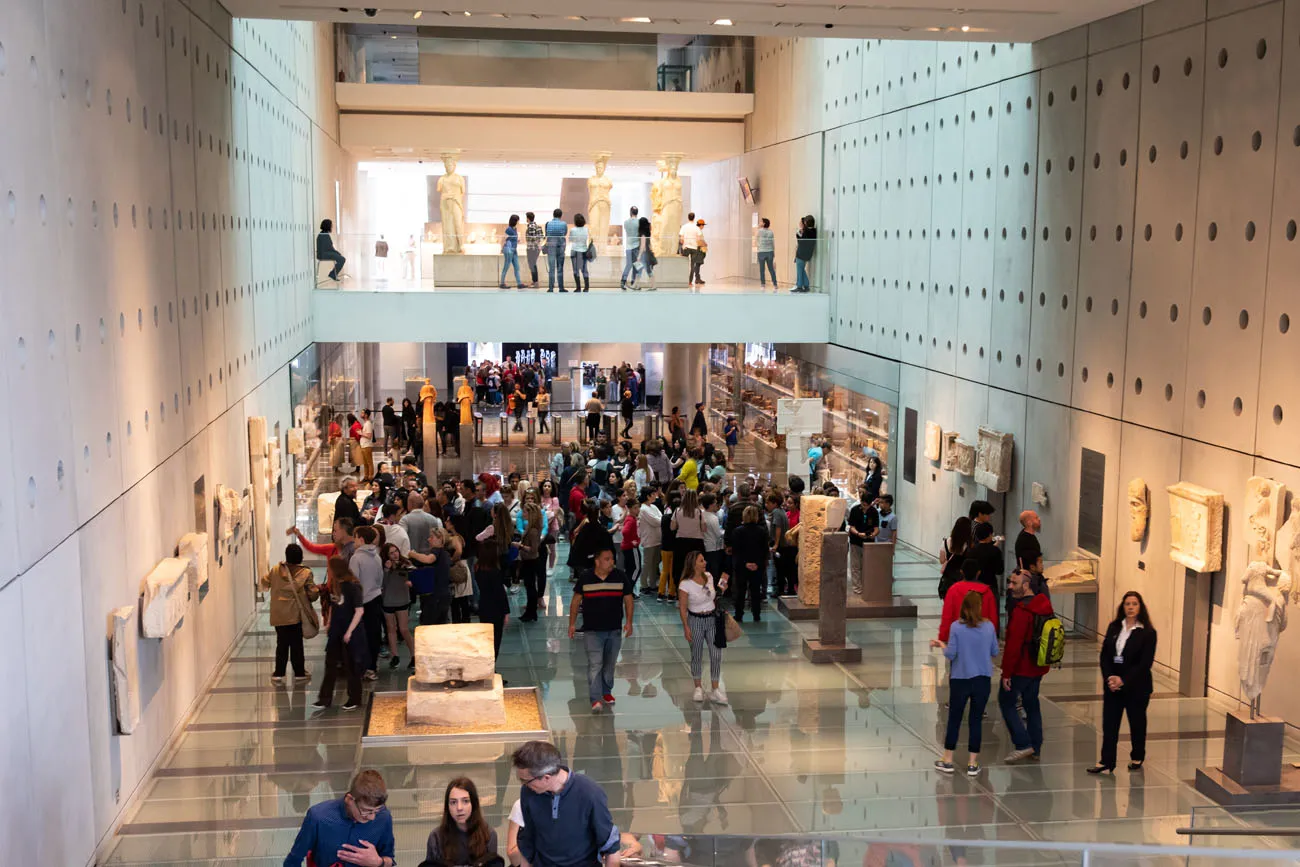
Acropolis Museum
This museum is located near the Acropolis. Lines can be long so it is best to purchase your tickets online in advance (tickets for the Acropolis Museum are sold separately from the Acropolis, although you can purchase an Acropolis + Acropolis Museum combination ticket with a guided tour on GetYourGuide).
Cost: €20
Hours: The Acropolis Museum is open daily. Hours vary by season. From April 1 to October 31, the museum opens at 9 am and closes between 5 pm and 10 pm, depending on the day of the week.
Website: For updated hours, pricing, and holidays, and to purchase your tickets in advance, visit the official website.
3. Ancient Agora & Temple of Hephaestus
The Ancient Agora is an archaeological site located near the Acropolis. For 5,000 years, this area was used as a marketplace, gathering place, and residential area. The ground of this large site is littered with the ruins of buildings and walkways. However, there are two important places to visit (the Temple of Hephaestus and the Stoa of Attalos).


The Temple of Hephaestus is one of the best-preserved Greek temples. It was constructed in the 5th century BC to honor the god Hephaestus, the patron god of fire, metal working, and craftsmanship.
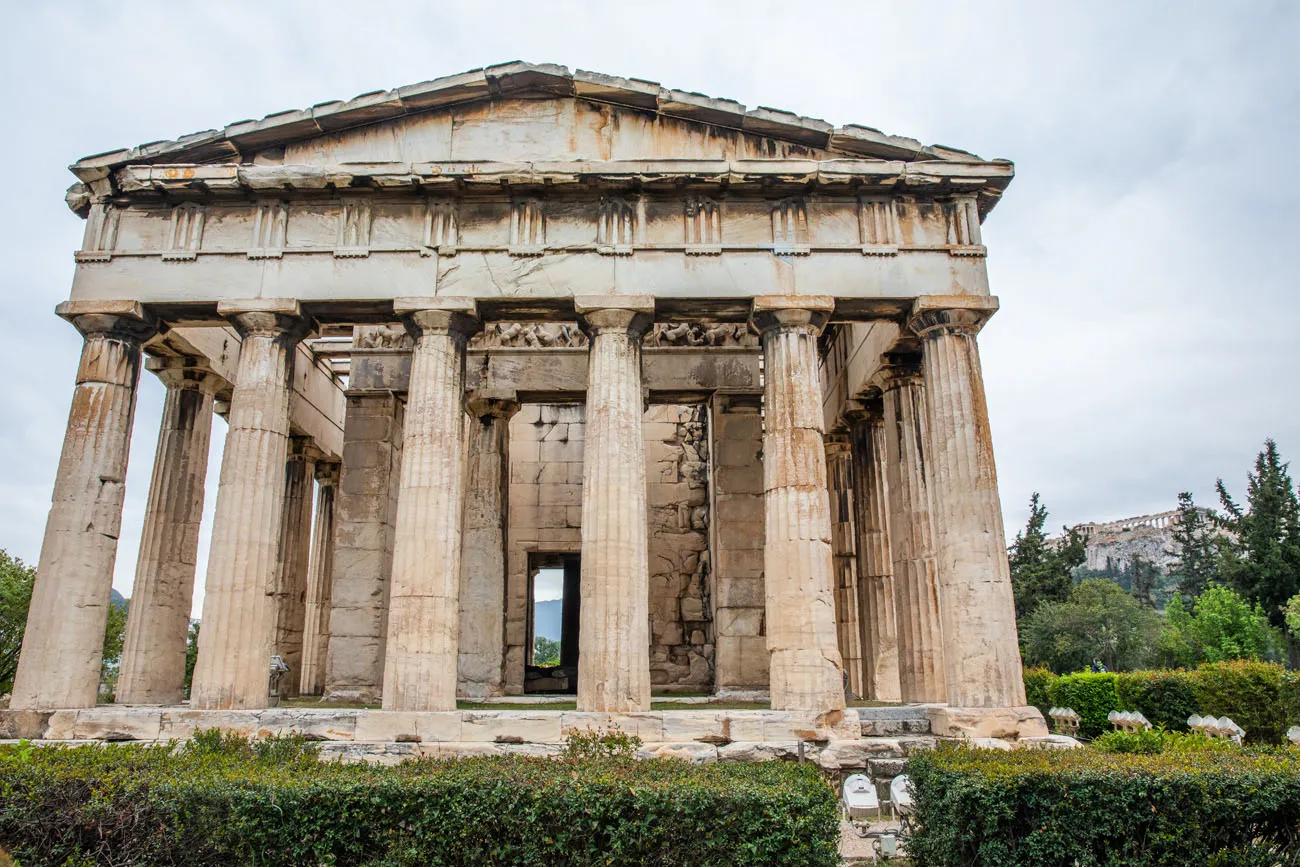
Temple of Hephaestus

The view of the Ancient Agora and Acropolis from the Temple of Hephaestus.
The Stoa of Attalos is a building that was reconstructed in the 1950’s and houses the Museum of the Ancient Agora.
Hours & Cost: Hours vary by season; get updated hours and pricing here; tickets can be purchased online in advance on the official website
4. Roman Agora
Located just a short distance away from the Ancient Agora is the Roman Agora. This market and collection of buildings was built in the first century BC during the rule of Julius and Augustus Caesar. The main entrance is through the Gate of Athena. The Tower of the Winds is considered to be the world’s first meteorological center, featuring a sundial, water clock, and wind vane.

Hours & Cost: Hours vary by season; get updated hours and pricing here; tickets can be purchased online in advance on the official website
5. Hadrian’s Library
Hadrian’s Library was constructed in 132 AD under the rule of Roman Emperor Hadrian. It was built to house rolls of papyrus books.

Hadrian’s Library
Hours & Cost: Hours vary by season; get updated hours and pricing here; tickets can be purchased online in advance on the official website
6. Temple of Olympian Zeus
Construction on the temple of Olympian Zeus began in the 6th century BC. It was built to honor Zeus and was planned to be the greatest temple in the ancient world. When finished, it was one of the largest ever of the ancient temples, with 104 unusually tall columns, each 17.25 meters tall. Not long after its completion in the 2nd century AD, it was pillaged by a barbarian invasion. Even though only fifteen of the original columns still stand, it is easy to recognize its grandeur.


Hours & Cost: Hours vary by season; get updated hours and pricing here; tickets can be purchased online in advance on the official website
7. Kerameikos
Kerameikos is an area of Athens that served as potter’s quarters and an ancient cemetery. A visit here is quick and you can walk among the excavations.

Kerameikos

Hours & Cost: Hours vary by season; get updated hours and pricing here
8. National Archaeological Museum
This museum is the largest archeological museum in Greece and houses one of the greatest collections of artifacts of Greek antiquity.

Getting Here: Closest metro stations are Omonia and Victoria stations. We took the metro to Omonia station and then it was a 10-minute walk to the museum.
PRO TRAVEL TIP: If you have plans to visit the Greek islands and you used Ferry Hopper to book your tickets, you can visit the Ferry Hopper office while walking from Omonia station to the museum. Picking up your tickets from the office in Athens is much faster than waiting in line at the port to pick them up.
Website: get updated hours and pricing on the official website
Skip-the-line Ticket: You can purchase a skip-the-line ticket here.
9. Benaki Museum
The Benaki Museum houses Greek works of art from prehistory to modern time, as well as an extensive collection of Asian art. The Benaki family donated their house and their enormous collection of art and artifacts to Greece.
Visit the official website for hours and entrance fees.
10. Plaka
Plaka is a neighborhood in Athens that stretches from the Acropolis to Syntagma Square. This is one of the best spots in Athens to go shopping. Ermou Street is a pedestrian street lined with popular stores like H&M, Sephora and Mango. The older and more interesting streets are located closer to the Acropolis. The Anafiotika area is a charming, older section of Plaka with narrow, photogenic streets and shops.
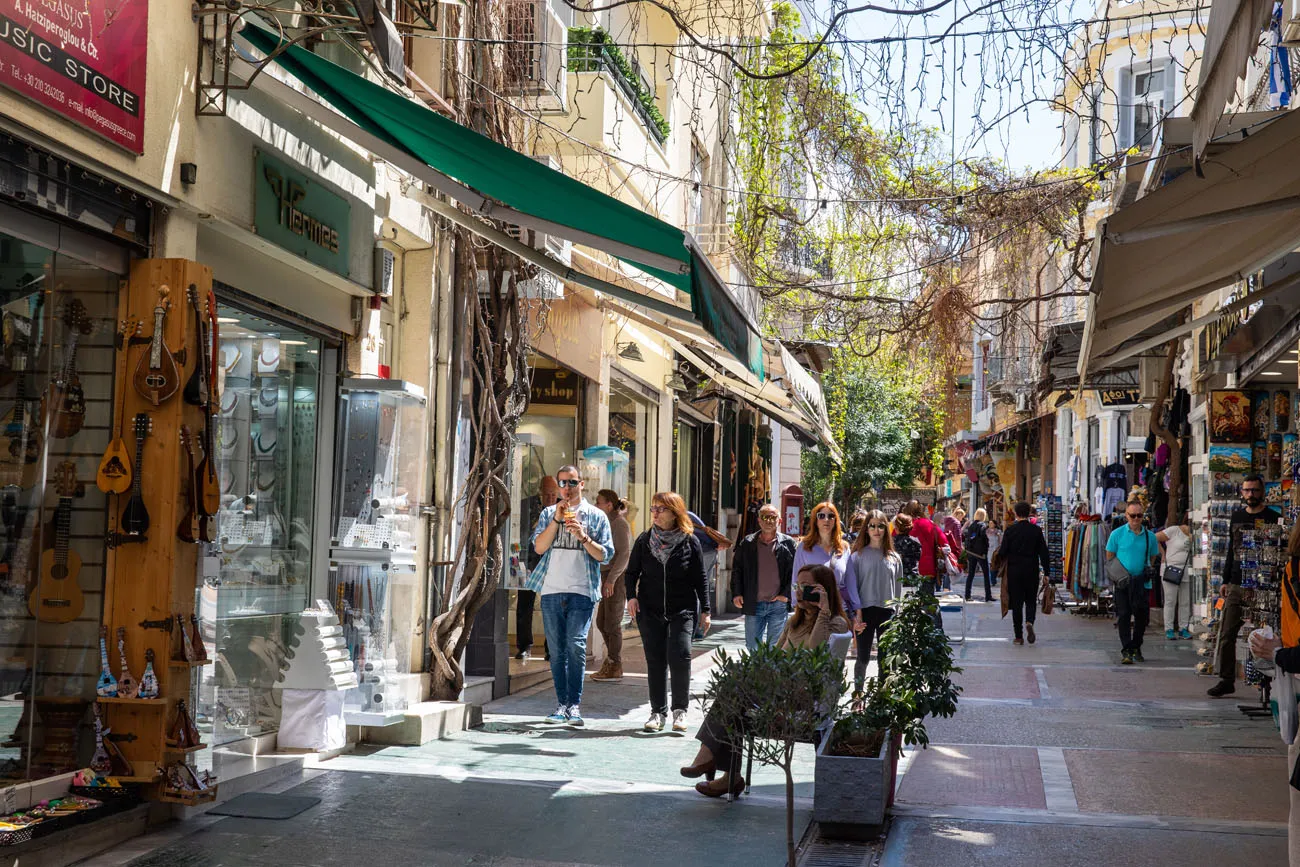
Plaka
11. Church of Panagia Kapnikarea
Located on Ermou Street in Plaka, this is one of the oldest churches in Athens. This Greek Orthodox church was built in the 11th century. It looks out of place, sitting among modern buildings and popular chain stores, as the city of Athens has grown up around it.
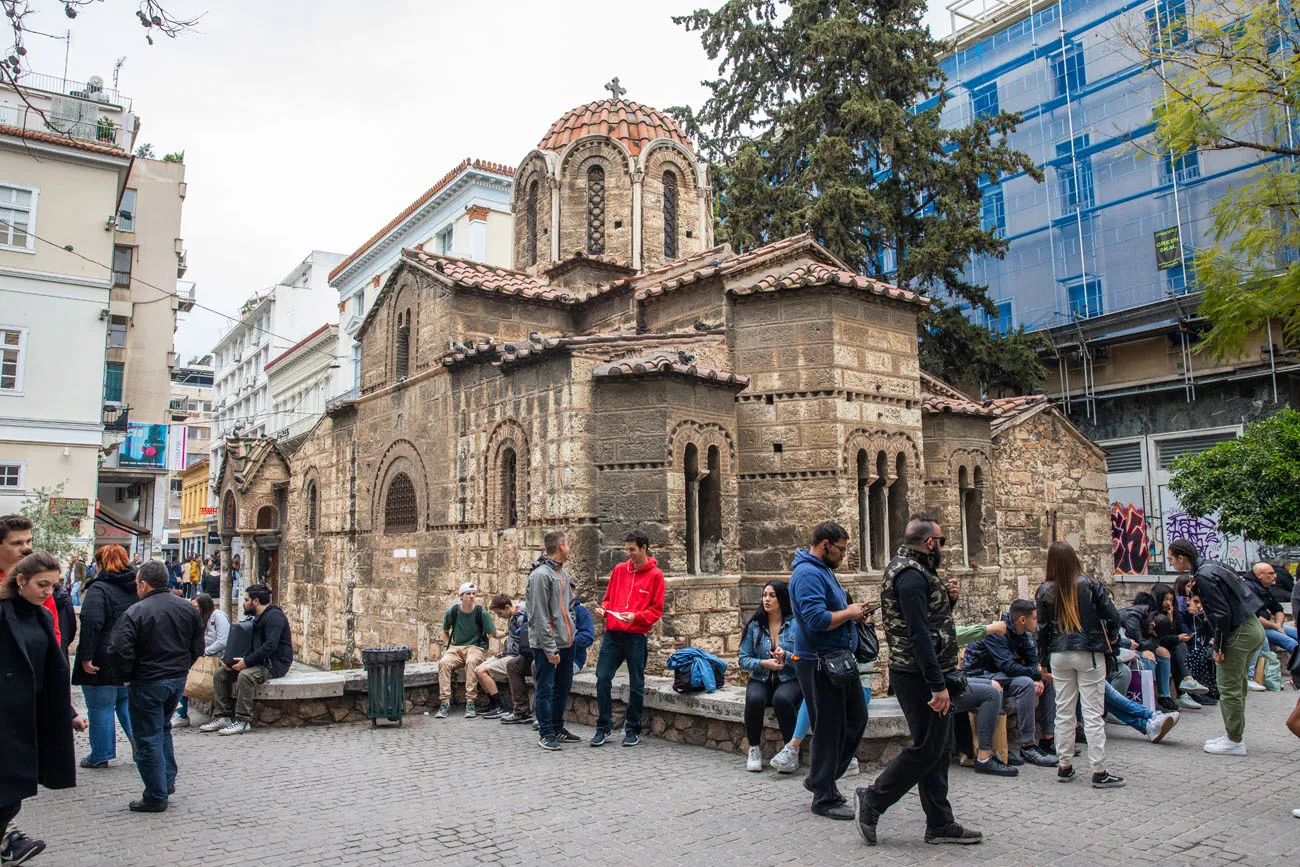
Church of Panagia Kapnikarea
12. Monastiraki Square
This is a bustling, busy spot in Athens. It’s located in the heart of Athens, near Hadrian’s Library, the Ancient Agora, and just a short walk from the Acropolis.
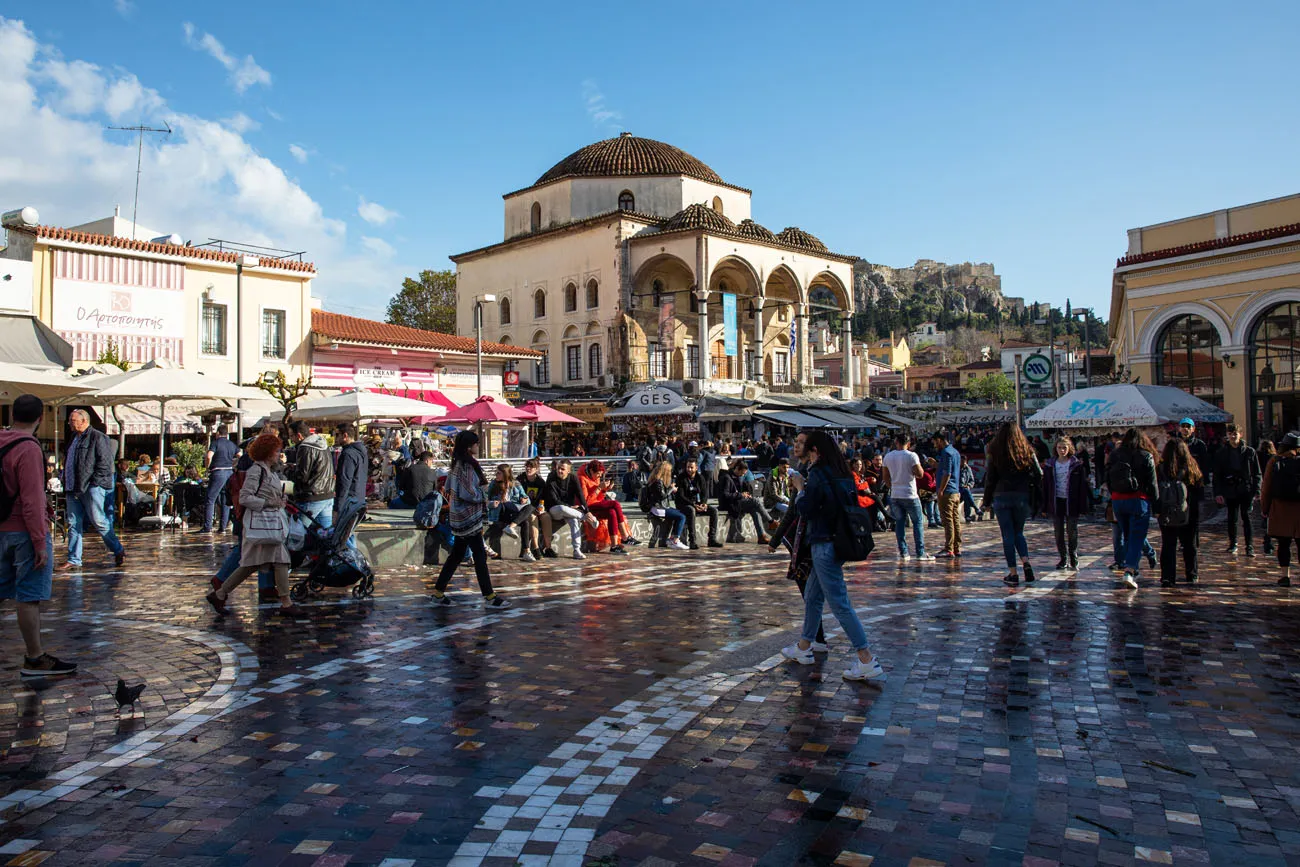
In this square is a Greek Orthodox church, a mosque, a metro station, the pillars of Hadrian’s Library, and a jumble of shops. On Sundays, a flea market dominates the square.
13. Take in the View from a Rooftop Bar
Numerous hotels offer rooftop restaurants, bars, and even swimming pools, which offer stunning views of the Acropolis.
Our favorite rooftop restaurant was A for Athens. From here, look out over busy Monastiraki Square, the Ancient Agora, and of course, the Acropolis.
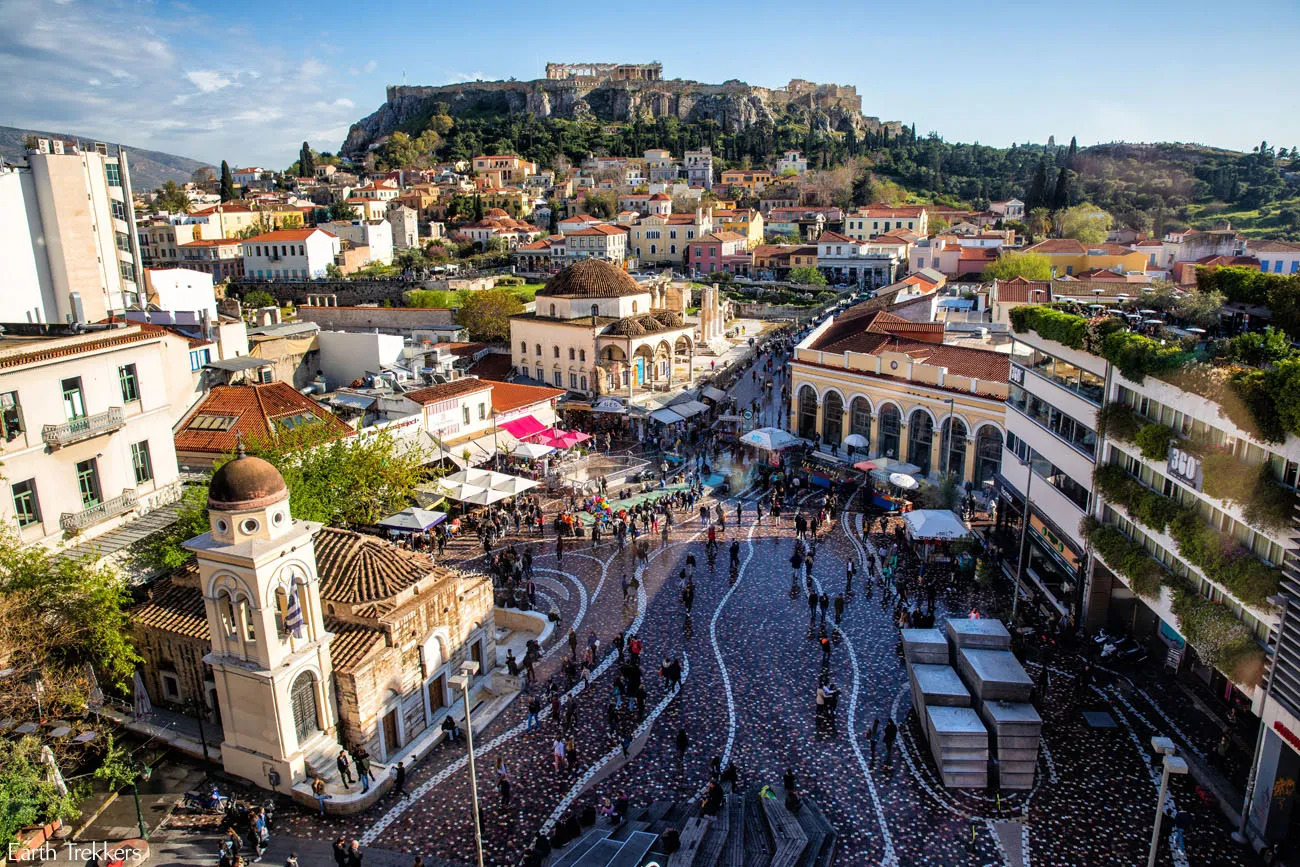
View from A for Athens rooftop bar
From the rooftop restaurant at the Athens Gate Hotel, you get 360° views over Athens. Not only do you get a gorgeous view of the Acropolis but you can also look out over the Temple of Olympian Zeus and Mount Lycabettus.

Athens Gate Hotel
Finally, the Hotel Grande Bretagne has a rooftop restaurant with views over Syntagma Square and the Acropolis.

There are also numerous hotels that offer rooms and rooftop bars with amazing views of the Acropolis. Read our post about where to stay in Athens to learn more.
14. Areopagus Hill
Areopagus Hill, also known as Mars Hill, is a spot to get one of the most iconic views of the Acropolis.

Areopagus Hill View | Best Things to Do in Athens
But this is more than a nice place to snap a photo. There is a lot of history and legend here. According to Greek mythology, this hill got its name from Ares, the god of war, who was tried here by the gods for the murder of Poseidon’s son Alirrothios. In ancient times, this was a meeting place where philosophy and law were discussed. It is also the location where the Apostle Paul gave one of his most important speeches.
Areopagus Hill is located very close to the main entrance into the Acropolis, so go here before or after you tour the Acropolis.
15. Philopappos Hill
Located just southwest of the Acropolis, Philopappos Hill (also spelled Filopappou Hill) is a hilly park laced with walking trails. The most popular viewpoint is located at the Monument of Philopappos, but you can also follow the other trails for a slightly different perspective of the Acropolis.

16. Mount Lycabettus
For a sprawling view of Athens and the Acropolis, walk or take the Lycabettus Cable Car to the peak of Mount Lycabettus. From here, you get to see just how big this city is, with the Acropolis proudly rising up in the center from the low, white buildings. In the sunlight, this city literally sparkles.

View from Mount Lycabettus
Getting Here: Unless you take a taxi right to the Lycabettus Cable Car station, expect to do some walking, and a lot of that will be uphill. The closest metro stops are Panepistimio and Evangelismos. From here, it will be an uphill walk to the cable car station. Or, you can choose to walk all of the way to the top on a paved trail that switchbacks its way up the hill. It’s about a 15-minute walk up this paved trail to the summit.
Cost: Free
17. Visit Psyrri
Psyrri (aka Psyri, Psiri, Psirri) is a funky, trendy little neighborhood not far from Monastiraki. We liked this neighborhood so much that we visited it twice. Filled with great restaurants, unique bars, a vibrant nightlife, and small boutique shops, this is a very cool spot to go out for dinner and drinks.

Psyrri

Grab a coffee or spoon sweets at Kalimeres. Go wine tasting at the Cinque Wine & Deli Bar. Have dinner at Lithos Tavern, a cozy restaurant that serves traditional Greek and Mediterranean food.
This is a cool spot in Athens and a great place to take a break from temples, ruins, and museums.
If you only have a half day in Athens and want to see the highlights, this private tour includes a visit to the Acropolis, Temple of Zeus, Panathenaic Stadium, Plaka, and Tomb of the Unknown Soldier.
18. Varvakeios Central Market
The Varvakeios Market is another great spot to take a break from museums and ancient historical sites. There are different sections to the market and we ended up wandering down a long hallway filled with meat vendors and their products.

Varvakeios Market
However, there is more than beef and lamb for sale at the market. There are also sections where you can buy fruit, vegetables, spices, seafood, and more.
The market is closed on Sunday.
19. Tomb of the Unknown Soldier
Located in Syntagma Square near the Hellenic Parliament Building, this is a war memorial that is dedicated to the Greek soldiers who died in war. The tomb is guarded by an Evzone soldier dressed in traditional uniform.

Every hour there is a changing of the guard. However, the most elaborate display takes place at 11 am on Sunday when a group of soldiers march to the tomb.
20. Panathenaic Stadium
This is a historic stadium and a lot of big events have occurred here. First of all, it dates back to 330 BC. In 144 AD, it was reconstructed in marble by Herodes Atticus. In 1896, it hosted the opening and closing ceremonies of the first modern Olympics. Then, in 2004, it was used as an Olympic venue. It is the site of the finish line for the Athens Classic Marathon.


Panathenaic Stadium
Get updated hours and pricing on the official website.
Best of Athens: On a Map
How to Use This Map: Click the tab in the top left corner of the map to see a list of the points of interest and to turn layers on/off. Click the icons on the map to get more information about each point of interest.
To take this map with you, click the star next to the title of the map which adds it to your Google account. Next, within your Google Maps app, select ‘Saved’ and then select ‘Maps’. This map title will now appear in your list.
Getting Around Athens
To get between Athens and the airport, you can take a bus, the metro, or a taxi. You can also book a private transfer in advance.
Almost everything on this list is within walking distance of the Acropolis. If you stay in the city center and don’t mind a lot of walking, you can see almost everything in Athens without using the bus, metro, or taxis.
If you want to limit your walking, you can use the fast, easy to use metro to hop around Athens. There are conveniently placed stations around the Acropolis at Syntagma Square (Syntagma Station), near the Acropolis Museum (Acropoli Station), at Monastiraki Square (Monastiraki Station), and near the Ancient Agora (Thissio Station). We took the metro to Omonia Station to visit the National Archaeological Museum (but you can also use Victoria Station).
Before our trip to Athens, I installed the Athens Sbwy app onto my phone. This is a free but very basic map of the metro system in Athens. It comes in handy if you plan to use the metro a lot, especially if you also plan to take the metro to the airport or Piraeus port.
You can purchase individual metro tickets for each journey (a good idea if you only plan to use the metro once or twice). You can also purchase a paper ticket that is good for five journeys on the metro. If you plan to stay 3 days or longer in Athens, consider purchasing the 3-day tourist ticket. Click here for an article that explains all of your options.
How Many Days Should You Spend in Athens?
We spent two full days in Athens and it was the perfect amount of time for us. It was a very busy two days but we visited everything in this article with the exception of the Benaki Museum.
One full day gives you enough time to visit the Acropolis and several more places. If you only have one day, I also recommend visiting the Acropolis Museum, several of the sites on the combination ticket (the Temple of Olympian Zeus, the Ancient Agora, etc), explore Plaka, and have dinner or a drink at a rooftop restaurant.
With two days you have enough time to visit everything on this list. You can even get to the Benaki Museum, we skipped it simply because we were on museum/historical site overload. Learn how to plan your itinerary in our 2 Days in Athens Itinerary ↓
2 Days in Athens: The Perfect Itinerary (+ New 2025 Rules)
Best way to spend 2 days in Athens.Three days lets you visit Athens at a more leisurely pace, visit more museums, take a day trip, and go shopping.
Where to Eat in Athens
Smak. This was our favorite restaurant in Athens. Smak is a “street food” restaurant that serves pizza and peinirli (a boat-shaped Greek pizza). The food is fresh, delicious, and cheap. You can get dinner here for less than €5 per person. It’s located just off of Ermou Street in Plaka.

Feyrouz. This is another great, cheap eat in Athens. Dine on traditional Lebanese food and don’t miss the soups that you drink right out of a cup.

A for Athens. Not only is the view over Athens incredible, but the food is great and so are the drinks.
Lithos Tavern. Located in the Psyrri neighborhood, this Greek tavern gets rave reviews.
Indian Haveli. The spot to go for Indian food. On Trip Advisor, it’s one of the highest rated restaurants in Athens.
Athens Gate Hotel. This hotel has a rooftop restaurant with one of the best views of the Acropolis. We ate dinner here and honestly, we thought the food was mediocre, especially for the price. However, dessert was amazing. I think this would be a great spot for drinks and sunset views of the Acropolis.
Interesting Facts About Athens
Athens is one of the world’s oldest cities with a history spanning 3,400 years.
Athens is referred to as the cradle of Western civilization and the birthplace of democracy. The first known democracy was established in Athens in the 6th century BC under the guidance of Cleisthenes, an Athenian leader.
Plato is a famous Athenian philosopher who is credited with starting the first institution for higher education in the western world. Plato was also the teacher of Aristotle, who is known as the “Father of Western Philosophy.”
The goddess Athena is the patron of Athens. Athena and Poseidon competed for patronage of Athens. During their battle, Poseidon struck the ground with his trident and a salt water spring welled up. Athena hit the ground with a rock and an olive tree grew in this spot. Both of these sites are honored with temples built on the Acropolis.
Despite the vast number of ancient archeological sites in Athens, only two of these are UNSECO World Heritage Sites: the Acropolis and the Daphni Monastery.
Athens is considered to be one of the hottest cities in Europe. The average high temperature during the summer months is 34°C (94°F). Athens also has the highest recorded temperature in Europe at 48°C (118°F) in July 1977. So, if you plan to visit Athens in June, July, or August, be prepared for hot, dry weather.
Where to Stay in Athens
Want a hotel room with a view of the Acropolis? How about a hotel that has a rooftop pool with amazing views over Athens? Whether you want to splurge on a luxury hotel or stay in hostel with glowing reviews, get recommendations in our article Where to Stay in Athens: Best Hotels for Your Budget.
A Few More Ideas
Tours & Tickets
If you have any questions about the best things to do in Athens, or if you want to share your experience, let us know in the comment section below.
More Information for Your Trip to Greece

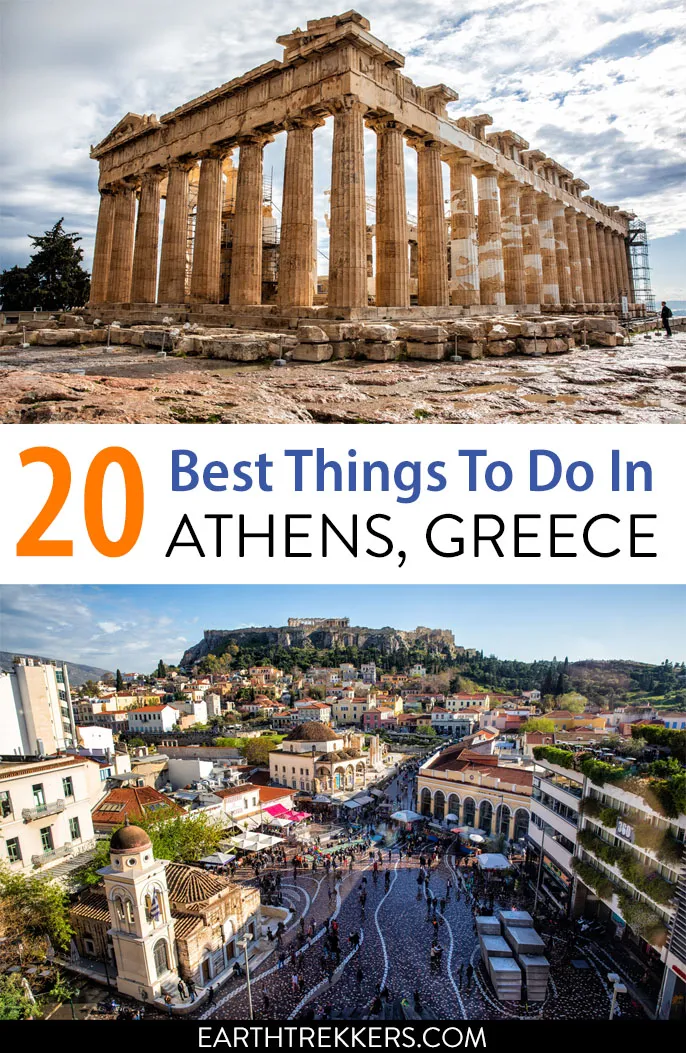


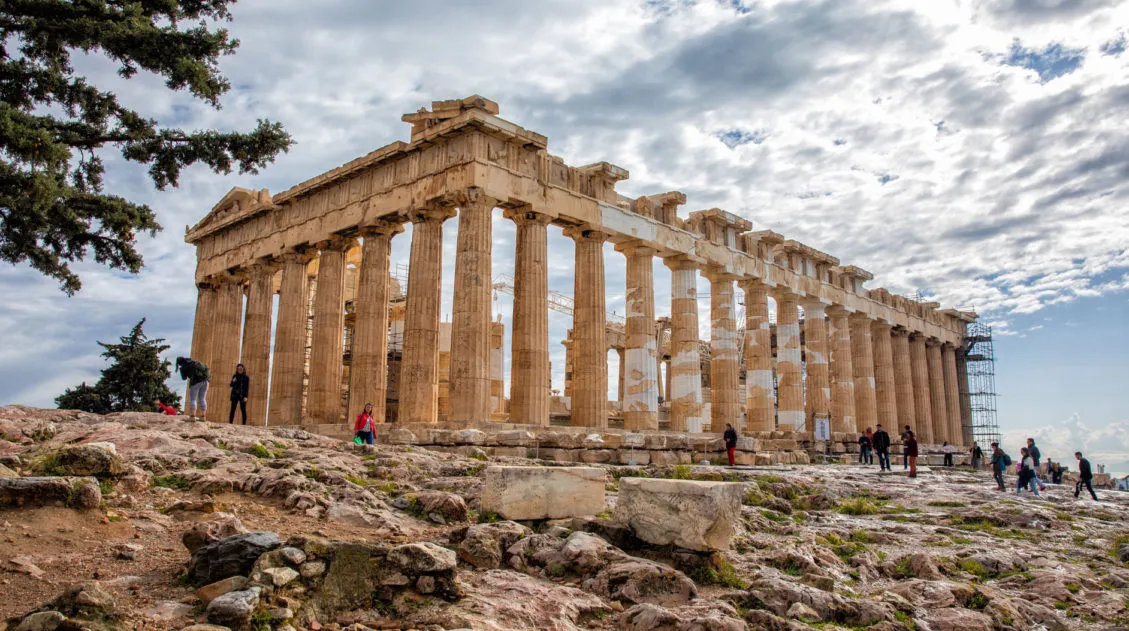











Comments 24